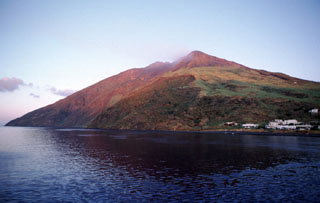Report on Stromboli (Italy) — 25 December-31 December 2024
Smithsonian Institution / US Geological Survey
Weekly Volcanic Activity Report, 25 December-31 December 2024
Managing Editor: Sally Sennert.
Please cite this report as:
Global Volcanism Program, 2024. Report on Stromboli (Italy) (Sennert, S, ed.). Weekly Volcanic Activity Report, 25 December-31 December 2024. Smithsonian Institution and US Geological Survey.
Stromboli
Italy
38.789°N, 15.213°E; summit elev. 924 m
All times are local (unless otherwise noted)
The Sezione di Catania - Osservatorio Etneo (INGV) reported that eruptive activity continued at Stromboli during 23-29 December. Webcam images showed Strombolian activity at four vents in Area N within the upper part of the Sciara del Fuoco and from at least three vents in Area C-S (South-Central Crater) on the crater terrace. The vents in Area N continued to produce low-to-medium intensity explosions, ejecting lapilli and bombs less than 150 m above the vents. Spattering continued at N2 vents and was sometimes intense, producing lava flows that descended the upper part of the Sciara del Fuoco on four occasions. Explosions at the vents in Area C-S ejected tephra more than 250 m above the vent. The rate of explosions in both areas was low.
Three of the four phases of intense spattering and lava overflows at vent N2 were notable, occurring on 24, 25, and 26 December. The first began at 0614 on 24 December with an explosion at N2 that ejected material onto the upper Sciara del Fuoco, within the gully that had formed in July; lava overflowed the crater until 0800. Intense spattering on 25 December produced lava flows during 0350-0600 and 2309-2340. On 26 December spattering intensified at 1937 and changed to lava fountaining during 1946-2010; lava overflowed the crater at 1952 and flows continued to be active until 0350 on 27 December. Material occasionally detached from the end of active lava flows and descended to the coastline. The Alert Level remained at Yellow (the second lowest level on a four-level scale).
Geological Summary. Spectacular incandescent nighttime explosions at Stromboli have long attracted visitors to the "Lighthouse of the Mediterranean" in the NE Aeolian Islands. This volcano has lent its name to the frequent mild explosive activity that has characterized its eruptions throughout much of historical time. The small island is the emergent summit of a volcano that grew in two main eruptive cycles, the last of which formed the western portion of the island. The Neostromboli eruptive period took place between about 13,000 and 5,000 years ago. The active summit vents are located at the head of the Sciara del Fuoco, a prominent scarp that formed about 5,000 years ago due to a series of slope failures which extends to below sea level. The modern volcano has been constructed within this scarp, which funnels pyroclastic ejecta and lava flows to the NW. Essentially continuous mild Strombolian explosions, sometimes accompanied by lava flows, have been recorded for more than a millennium.
Sources: Sezione di Catania - Osservatorio Etneo (INGV), Dipartimento della Protezione Civile

